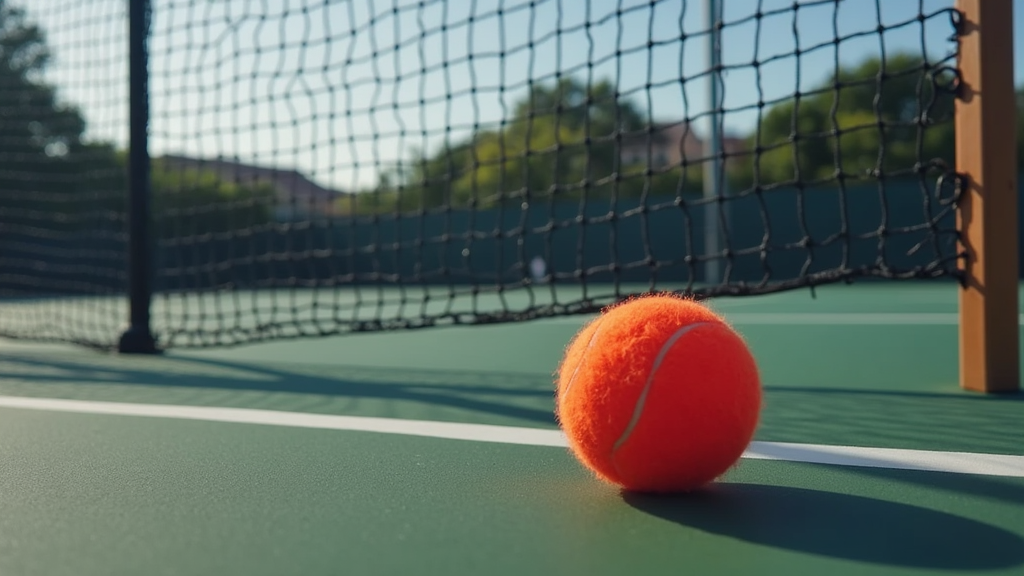Table of Contents
Introduction

Overview and Importance
Pickleball net systems are absolutely essential for ensuring fair and enjoyable gameplay. Whether you’re setting up a dedicated pickleball court or converting a space for a quick match, the net is the centerpiece. Adhering to established standards for net height and tension is paramount to guaranteeing consistent play, regardless of the location. This consistency allows players to develop their skills and strategies without having to adjust to varying net conditions.
The popularity of pickleball has exploded in recent years. As of 2023, there are over 4.8 million pickleball players in the United States alone, and this number continues to grow rapidly. This surge in popularity has led to an increasing demand for both dedicated pickleball courts and multi-use courts that can be easily adapted for pickleball. With more people playing, the importance of properly installed and maintained net systems cannot be overstated.
Proper installation isn’t just about aesthetics; it directly impacts safety, fair play, and the longevity of the net system itself. A poorly installed net can be a hazard, leading to trips and falls. Incorrect net height or tension can unfairly advantage one player over another. Moreover, improper installation can put undue stress on the net and its components, shortening its lifespan and requiring more frequent replacements.
Background
Pickleball’s story began in 1965 on Bainbridge Island, Washington, when Joel Pritchard, Bill Bell, and Barney McCallum sought to entertain their bored children. Using what they had on hand – a wiffle ball, some paddles, and a badminton net – they inadvertently created a new sport. As the game evolved, so did the equipment. The need for standardized equipment became apparent, leading to the development of official pickleball nets and paddles.
Recent years have witnessed significant advancements in pickleball net technology. We’ve seen the introduction of improved materials that offer greater durability and weather resistance. Portable net designs have become increasingly popular, allowing players to set up courts virtually anywhere. The United States of America Pickleball Association (USAPA) has played a crucial role in establishing and maintaining regulations for net height, tension, and overall construction, ensuring a consistent and fair playing experience for everyone.
What You’ll Learn
In this guide, we’ll delve into the core concepts you need to understand about pickleball net systems. We’ll explore the different types of net systems available, from permanent installations to portable options, and examine the various components that make up each system. You’ll gain a solid understanding of what to look for when choosing a net system that meets your specific needs.
Beyond the theory, we’ll provide practical, step-by-step installation guides for both permanent and portable net systems. Whether you’re setting up a net on a dedicated court or transforming your driveway for a weekend game, we’ll walk you through the process, ensuring that your net is installed correctly, safely, and according to official regulations. By the end of this guide, you’ll have the knowledge and skills to confidently install and maintain your pickleball net system, ensuring countless hours of enjoyable and fair play.
Understanding the Basics of Pickleball Net Systems
Fundamental Concepts
Before diving into the specifics of pickleball net systems, it’s crucial to grasp the fundamental concepts that underpin their design and usage. A pickleball net system is more than just a barrier; it’s a key component that defines the playing field and ensures fair competition. There are two primary types of net systems: permanent and portable.
- Permanent Net System:A net system designed for fixed installation, typically anchored into the ground or a court surface. These are ideal for dedicated pickleball courts where consistent play is expected.
- Portable Net System:A net system designed for easy transport and setup. These are perfect for recreational players, temporary courts, or locations where a permanent installation isn’t feasible.
- USAPA Standards:Regulations established by the USA Pickleball Association (USAPA) that dictate the precise dimensions and specifications for pickleball nets. These standards ensure consistency and fair play across different venues.
The core principles guiding the selection and use of a pickleball net system are stability, durability, portability (if applicable), and strict adherence to USAPA standards. A net system must be stable enough to withstand regular use and accidental impacts. It should be durable enough to endure various weather conditions and resist wear and tear. Portable systems must be easily transportable and set up. Above all, every net system should conform to USAPA standards regarding height and width to guarantee a consistent and regulated playing experience.
Essential Components
A pickleball net system comprises several essential components, each playing a vital role in its overall functionality. Understanding these components and their key features is crucial for selecting the right net system for your needs.
- Net:The net itself is typically made of polyethylene or braided nylon. These materials are chosen for their strength, durability, and resistance to stretching or sagging.
- Support Structure:The support structure consists of posts or frames that hold the net in place. These are commonly made of metal, such as steel or aluminum, for permanent systems. Lightweight alternatives like fiberglass or PVC are often used in portable systems.
- Tensioning System:The tensioning system includes straps, hooks, or fasteners that allow you to adjust the tautness of the net. Proper tension is essential for maintaining the correct net height and ensuring fair gameplay.
When choosing a pickleball net system, consider the following key features:
- Primary Aspects:
- Secondary Aspects:
- Material Durability:The materials used in the net and support structure should be weather-resistant and rust-proof to withstand outdoor conditions and ensure longevity.
- Ease of Setup and Takedown:For portable systems, the ease with which the net can be set up and taken down is a critical factor. Look for systems with intuitive designs and minimal parts.
- Compliance with USAPA Standards:Ensure that the net system meets USAPA standards, which require a width of 20 feet, a height of 36 inches at the sidelines, and a height of 34 inches at the center.
- Weight and Portability:Consider the weight and portability of the system, especially if you plan to transport it frequently.
- Storage Requirements:Think about the storage space required for the net system when it’s not in use.
- Aesthetic Appeal:While not essential, the aesthetic appeal of the net system can contribute to the overall enjoyment of your pickleball court.
Finally, be aware of the important variations that exist among pickleball net systems:
- In-ground vs. Surface-mounted Posts:Permanent systems can have in-ground posts, which are cemented into the ground, or surface-mounted posts, which are bolted to the court surface.
- Frame Material:Portable systems come with frames made of various materials, including aluminum, steel, and PVC, each offering different levels of durability and portability.
- Net Attachment Methods:Nets can be attached to the support structure using hooks, straps, or fasteners, each offering varying degrees of adjustability and ease of use.
Detailed Guide

Preparation
Before you can enjoy a game of pickleball, setting up your net correctly is crucial. Whether you’re opting for a permanent or portable system, careful preparation will save you time and frustration.
Required materials:
- Permanent Systems:Net, posts, ground sleeves or cement, level, measuring tape, tools for digging and mixing cement (if applicable).
- Portable Systems:Net, frame, carrying bag, measuring tape.
Initial setup:
- Permanent Systems:Mark court dimensions according to USAPA standards. Accurate measurements ensure fair play and adherence to official guidelines.
- Portable Systems:Unpack the net and frame components. Familiarize yourself with all the parts and the assembly instructions.
Important considerations:
- Check local regulations for permanent installations. Some areas may have restrictions on permanent structures in residential areas.
- Ensure a level surface for both types of systems. An uneven surface can affect net tension and gameplay.
- Review manufacturer instructions before starting. Each system is unique, and the instructions are your best guide.
Step-by-Step Process
Now that you’re prepared, let’s dive into the installation process. Follow these clear instructions to set up your pickleball net like a pro.
Clear instructions:
- Permanent Systems:
- Portable Systems:
Best practices:
- Use a level to ensure posts are vertical (permanent systems). This prevents leaning and ensures even net tension.
- Double-check net height at multiple points (both systems). Accuracy is essential for fair play.
- Secure portable systems to the ground in windy conditions. Use stakes or weights to prevent tipping.
Common mistakes to avoid:
- Incorrect hole depth (permanent systems). Too shallow, and the posts won’t be stable; too deep, and you’ll waste cement.
- Over-tightening net tension (both systems). This can damage the net or frame.
- Neglecting to check USAPA height standards (both systems). Incorrect height violates official rules.
Advanced Techniques
Want to take your net setup to the next level? These advanced techniques will help you optimize performance and longevity.
Expert tips:
- Use quick-drying cement for faster installation (permanent systems). This reduces waiting time.
- Add sandbags or weights to the base of portable systems for added stability. Especially useful on windy days.
- Apply a rust-preventative coating to metal components (both systems). This prolongs the life of your net system.
Optimization methods:
- Adjust net tension regularly to maintain optimal play. Temperature and humidity can affect tension.
- Store portable systems indoors when not in use. This protects them from the elements.
- Replace worn or damaged components promptly. This prevents further damage and ensures safety.
Troubleshooting:
- Net sags in the middle: Tighten tensioning straps or adjust post height. Sagging indicates insufficient tension.
- Posts lean or wobble: Ensure proper ground sleeve installation or add additional support. Instability poses a safety risk.
- Frame is unstable: Check for loose connections or damaged components. Tighten connections or replace damaged parts.

